|
FAQs about Nudibranch Identification
6
Related Articles: Nudibranchs, Sea Slugs,
Related FAQs: Nudi ID
1, Nudi ID 2, Nudi ID 3, Nudibranch
ID 4, Nudibranch ID 5, Nudibranch ID 7, Nudibranch ID , &
Nudibranchs 1, Nudibranchs 2, Berghia Nudibranchs, Nudibranch Behavior, Nudibranch Compatibility, Nudibranch Selection, Nudibranch Systems, Nudibranch Feeding, Nudibranch Disease, Nudibranch Reproduction, & Sea Slugs, Marine
Snails 1, Marine Snails 2,
Marine Snails 3,
|
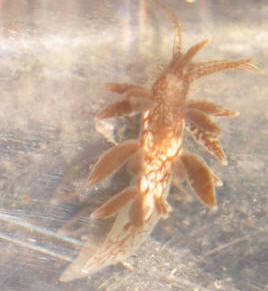
|
Nudibranch hitchhiker 10/12/09
Hello,
<Hi there>
I set up a new 50G tank about 2 months ago after some success (and
failures) with a 14G nano. As part of the setup, I bought some live
rocks. After the tank was cycled, I saw a black Nudibranch with a thin
blue edge around its body.
<Mmm, though there are many species of Nudibranchs... of many
colour/patterns, I suspect that what you saw/have is actually a
Flatworm.
Please see here for some examples:
http://wetwebmedia.com/flatworms.htm>
I tried to identify from your website and other sources from the
internet, but I am not able to find the a matched photo to ID it. From
its structure, I believe it is of the genus Chromodoris or
Hypselodoris. I
understood that they are carnivores, and they are poisonous. The latter
makes me worry. My tank is not large, and because it is new, there
can't be enough living things for the Nudibranch to feed on. At the
beginning I have some bristle worms and amphipods, I can't see them
any more, may be it is the act of the Nudibranch or the Heniochus. I am
kind of surprise it is still living and wandering around (it
particularly like to stay around the water line), but I think it
won't be able to survive long in the tank because I think the tank
should not have enough food for it. If it dies, then I worry it will
release poisonous stuff and kill the other tank mates.
Is this true? If so, should I remove it before the tank mates get
killed?
<In this volume, 50 gallons... I don't think there is much risk
of this animal poisoning anything>
Thanks in advance,
Simon
<Welcome. Bob Fenner>
Re: Nudibranch hitchhiker... Hey, this guy's
pretty good... 10/12/09
Hi Bob,
Thanks for the quick response. I read the article you pointed below,
yes, it is a flat worm Pseudoceros sapprinus, and sounds like it is a
beneficial animal. I will definition keep it.
Thanks again,
Simon
<Welcome! BobF>
|
Nudibranch? Yes, a Dorid: Likely Rostanga species --
10/2/09
Hi Crew!
<Hello, Nancy, Lynn here today.>
I have an ID question for you.
<My favorite kind!>
I found this little guy on my spider sponge today.
<Beautiful sponge/Parazoanthus combo. Unfortunately, it can be
very difficult to keep the supporting sponge alive. Most often,
what you see is a gradual decline/disappearance of the sponge
that ultimately results in what looks like a melted pile of white
Parazoanthus at the base. On the positive side, some hobbyists
have been able to keep these. It's not impossible, just very
difficult. I'd recommend lots of research!>
I am guessing he is not reef-friendly, or at least
sponge-friendly.
<You're right. This is a good example of a Nudibranch
species blending in with its food source -- namely, the sponge.
What you have is a Dorid Nudibranch, most likely in the genus
Rostanga. They prey on mostly orange to red sponges, have upright
gills (the posteriorly located feathery structures), and tend to
match their particular prey food in color and texture. The rather
hairy appearance is due to a covering of caryophyllidia, calcium
carbonate/spicule bearing papillae.>
I have quarantined him in a Reef Gently container inside this
tank, just in case you say he's ok to keep, I can easily
release him back into my tank. He's awful cute,
<He is indeed!>
..and would hate to 'flush" him. Any suggestions on what
to do with him?
<I'm sorry to say that this comes down to a choice between
keeping either the sponge or the Nudi. If you return the Nudi to
the tank, it'll survive but at the cost of the sponge. If you
remove the Nudi from its sole food source, it'll slowly
starve to death. Unfortunately, one will die either way, so
I'll let you make that decision.>
I'm pretty sure it's a Nudibranch, what kind is he??
<It's a Dorid (family Dorididae), most likely in the genus
Rostanga. Unfortunately, I can't narrow it down much further
without knowing where this little fellow originated. Even then,
these Nudi's vary in color and texture so it would still be a
guess. Solid ID requires examination of the radula (a tongue-like
scraping organ) and rhinophores (the two anteriorly placed
antennae). For examples/more information regarding these
beautiful little Nudibranchs, please see the individual Rostanga
species listed about halfway down this link:
http://www.seaslugforum.net/specieslist.cfm
Here's an example (Rostanga bifurcata):
http://www.seaslugforum.net/factsheet.cfm?base=rostbifu >
Thanks, Nancy
<You're very welcome. Take care, LynnZ>
|
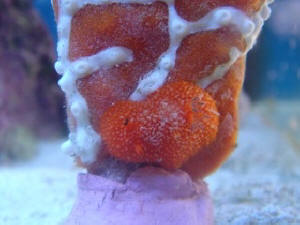 |
|
Nudibranch or Cucumber? Nudibranch: Likely Tritoniid
-- 9/22/09
Hello Crew!
<Hello, Tim!>
Can you identify this marine invertebrate for me please?
<I'll sure try!>
It was a hitchhiker on my liverock. I'm not sure if it's
a Nudibranch or a cucumber.
<It looks like a neat little Nudibranch rather than a
Cuke/Holothuroid but I can certainly understand the confusion.
Both have species with similar body shapes and branched
structures around the head/mouth. In the case of Holothuroids,
those structures are actually branched oral tentacles used for
feeding, and typically number anywhere from 10-30. In comparison,
Nudibranchs have oral tentacles along with two 'antennae'
called rhinophores. Both tentacles and rhinophores can range in
appearance from simple to highly branched/ornate. I think what
you have is a Nudibranch in the suborder Dendronotina, family
Tritoniidae. Tritoniids feed on soft corals (especially Xenia),
so if you have any in your system, I'd remove this little
guy. If you'd like to pursue this ID further, please see the
following link for a list of species in the above-mentioned
family (each is a link with more information/photos):
http://www.seaslugforum.net/specieslist.cfm
Start with the genera Marionia and Tritonia. The genus
Marionopsis is also a possibility, but not listed (try a Google
or other search engine). You might also want to check the family
Bornellidae as well (at the above link). There are some
similarities around the head but the structures
('cerata') running along either side (down the back) tend
to be simpler in shape (less delicate and finely
branched).>
Thank you for the help in advance,
<You're very welcome -- that's a neat little
critter!>
Tim
<Take care, LynnZ>
|
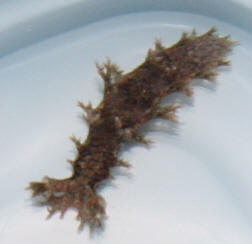 |
|
Worm? Slug? Nudi? Oh my! 9/20/09
Hi again all, and thanks in advance for all your previous
help.
<Hello, and welcome!>
Last week we purchased a Pipe organ coral, on a trip to the
coast. Got it home safely, adjusted well, and is beautiful.
However we have another hitch hiker, one that I have tried for
days to identify. it looked like an
anemone in the middle of the pipe organ, but only able to see
little tentacle things waving once the pipe went to bed.
<I see it too!>
Now this evening, when checking out the tank, and turning off
lights, we noticed the "hitch hiker" looks like a worm,
but kinda different. I've attached pics. Hope someone can
help!
Hope it wont hurt any of our sea life. any info would help!
Thanks again!
~Monique
<Looks to be a Nudibranch of the genus Phyllodesmium... Please
see the Net re... some are predaceous on animals purposely kept
by marine aquarists. Bob Fenner>
|
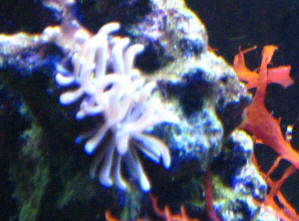 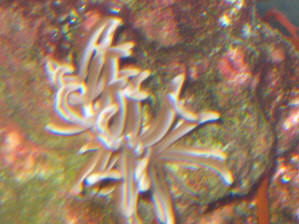 |
Re: Worm? Slug? Nudi? Oh my!
9/20/09
Thanks so much for your help. We have since, found out exactly what
he is a Phyllodesmium briareum and have removed him from our coral
tank (pretty sure he ate ALL of our pipe organ, maybe 3 or 4 tuffs
survived ) and have put him into my FOWLR where there isn't any
corals for him to destroy. Not sure if that means he wont survive,
but our precious corals are more valuable at this point than some
hitchhiking punk. Thanks again SOOOooo much for your help.
~M
<Welcome! B> |
|
Stowaway Nudibranch, Xeniid pred.
04/20/09
Hi crew :D
I recently bought a lovely colony of red sea xenia which was home
to a Phyllodesmium hyalinum - the little Nudibranch fell off the
colony when it was knocked off the rock work. While this may
sound a bit sad I know, the little guy is rather lovely and
although I have no wish for it to snaffle my xenia I'd like
to know if I can help it to survive, short of putting it back on
the xenia colony...
<If it is indeed a Xenia eating Nudibranch, chances are that
it needs to eat Xenia in order to survive. However, you might be
able to feed it any kind of Xenia. Thus, you might be able to set
up a little biotope for it and just feed it xenia frags (if you
can find such for cheap). The other option, you could ask your
fellow reef aquarists if they have excess Xenia (many reef
keepers do-- some even consider the coral a pest at some
point).>
after all, I did purchase the animal albeit accidentally!
<I do sympathize, appreciate your sentiment here. I recall a
friend of mine who fell so much in love with two beautiful
Nudibranchs that hitchhiked on his sun corals, that he forgot
about the sun coral and did everything he could to keep the slugs
alive by buying dying sun corals from LFSs, just to feed them. Of
course, I don't recommend this per se, but I do sympathize
with any such love for Nudibranchs. I've also had them as
hitch-hikers and always wished I could keep them. However, do
know that these animals don't usually live that long (even in
the wild).>
Will the Nudibranch ultimately cause the death of the xenia, or
will its feeding habits do little more than limit the size of the
colony?
<Well, firstly, please do send in a pic so that we can confirm
that this is a Xenia eating Nudibranch. Secondly, *one*
Nudibranch on a large, fast-growing Xenia colony, might not
destroy the colony, but as you say, just keep it
"mowed" a bit. The trouble is that the Nudibranch could
likely reproduce. Within a short time, you might not just be
dealing with one Nudibranch, but many many Nudibranchs... who
would likely destroy the colony eventually.>
Many thanks,
Carolyn
<De nada,
Sara M.>
Re: stowaway Nudibranch 04/21/09
Hi Sara,
Many thanks for the reply - have attached a picture of the little
guy.
<Wow, great pic! May I ask, what camera did you use? The slug
does look like a Phyllodesmium hyalinum. Please see here:
http://www.seaslugforum.net/display.cfm?id=13207
You might even want to write in to this site with your
story/pics, since it is noted to be very difficult to find/see in
the wild. Thus, maybe Bill Rudman would get a kick out of seeing
yours (or at least confirm the ID).>
Carolyn
<Cheers,
Sara M.>
|
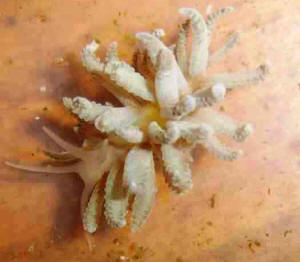 |
|
Unidentified Animal: Aeolid Nudibranch: Soft Coral
Predator - 4/13/09
Hi Crew -
<Hi there, Kevin>
Can you identify the attached image? I found this beast crawling
in my 34G reef tank this morning. Any information you can provide
would be greatly appreciated!
<It looks like Phyllodesmium magnum, an Aeolid Nudibranch with
a taste for soft corals. It's a beauty, but not something you
want to see cruising around your favorite coral! For more
information, please see the FAQ's titled: 'Nudibranch and
baby? 12/11/08' as well as 'Re: Much more re: Nudibranch
and baby?-12/11/08' at this link:
http://www.wetwebmedia.com/nudiidf4.htm . >
Thanks,
Kevin
<You're very welcome. Take care, LynnZ>
|
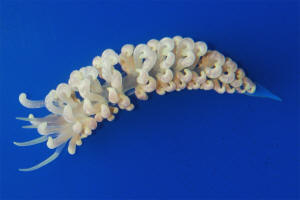 |
|
Re: Finger Leather 04/11/09
Sara M.,
The finger leather mentioned below did continue to show signs of
spreading.
We fragged off the bad parts. During the night hours, we
discovered what was causing the damage. Attached is a
picture.
<Uh oh, looks like trouble!>
Can you confirm that it is a Tritoniopsis?
<I'm no Nudibranch expert, but based on the look of the
thing (and where you found it), I would certainly feel safe
assuming that that's what this is. Especially after reading
the info here:
http://www.seaslugforum.net/factsheet.cfm?base=Triteleg>
We believe that the circle design in the first picture sent was
possibly the eggs from this Nudibranch. There are similar
pictures on the Sea Slug forum. Would you agree with our
assumption?
<Yes... now the real question, how will you get rid of them? I
would
suggest quarantining the coral for starters.>Thanks again.
Cindy
<De nada,
Sara M.>
|
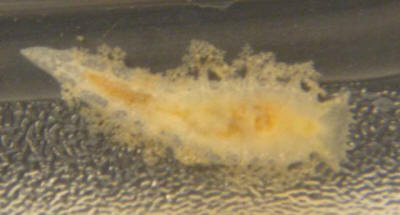 Nice pic! RMF Nice pic! RMF |
Finger Leather 04/11/09
Forgot to ask, should we worry about any of these other corals we
have in our tank? We have read that it typically eats soft
corals.
Sun Coral
Acropora
Mushrooms
Tridacna Crocea
Blue Spruce Caulastrea
<Most coral eating Nudibranchs are very picky eaters. Most will
only eat a few species or genera of coral (some are even specific
to just one species!). As far as I know the Tritoniopsis elegans
Nudibranch only feeds on Lobophyton sp. So your other corals should
be safe from them.>
Thanks.
<Thanks for sharing the pics.
Cheers,
Sara M.> |
|
Nudibranch ID help 05/29/09
I can't find a match for this lil critter, the Nudi's
body is apprx. 1/4 "long. Thank you, Paul
<Hmm, can you give us any more information? Did you find this
little guy on one of your corals? What corals do you have?
Cheers,
Sara M.>
Re: Nudibranch ID Help: Zoanthid Predator --
5/30/09
<Hello Paul, Lynn here this afternoon.>
I recently set up a new tank, it was a hitchhiker on one of the
frags
<Betcha it arrived on the Zoanthids.>
... it was on the glass, if you zoom in it is actually a
beautiful Nudi
<Yes, it is.>
..but I have it in a specimen cup till I can find out if it is
safe in the tank.
<Good, because it's definitely not safe around your
Zoa's.>
It was on the glass not a coral
<Good. What you have looks very much like a notorious Zoanthid
eating Nudibranch. They're mostly a brownish/orange and
white, but take on the color of the Zoa's they're preying
upon. For more information, please see the following link,
starting at 'Re: Polyp-feeding Nudibranch' all the way
down through the 'Re: Perhaps a gorgonian feeder?' posts:
http://www.seaslugforum.net/showall.cfm?base=palyfeed
Terrific photo:
http://coralpedia.com/index.php?module=Gallery2&g2_itemId=641
More photos, showing color variation:
http://coralpedia.com/index.php?module=Gallery2&g2_itemId=415
I'd keep a close eye on your Zoa's for any indication of
predation or signs of additional Nudi's. If you see either,
please refer to WWM's FAQ's for removal tips. Just enter
Zoanthid Nudibranch in the Google search engine:
http://www.wetwebmedia.com/Googlesearch.htm >
..but I have frags of Zoa's, pipe organ, Montipora danae,
chalices and good ole GSP in that tank.
<All but the Zoanthids should be in the clear -- at least as
far as these particular Nudi's go! Take care, LynnZ>
|
 |
|
FAQs about Nudibranch Identification
6
Related Articles: Nudibranchs, Sea Slugs,
Related FAQs: Nudi ID
1, Nudi ID 2, Nudi ID 3, Nudibranch
ID 4, Nudibranch ID 5, Nudibranch ID 7, Nudibranch ID , &
Nudibranchs 1, Nudibranchs 2, Berghia Nudibranchs, Nudibranch Behavior, Nudibranch Compatibility, Nudibranch Selection, Nudibranch Systems, Nudibranch Feeding, Nudibranch Disease, Nudibranch Reproduction, & Sea Slugs, Marine
Snails 1, Marine Snails 2,
Marine Snails 3,
|

|
|
|

